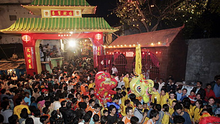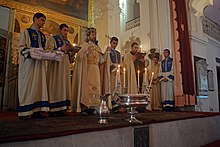Ethnic communities in Kolkata

| Languages | Population |
|---|---|
| Bengali | 2,763,291 |
Hindi
|
1,027,173 |
Urdu
|
586,234 |
| Odia | 26,158 |
| Gujarati | 25,667 |
| Punjabi | 15,913 |
| English | 8,900 |
| Nepali | 8,089 |
| Sindhi | 3,724 |
| Others | 40,445 |
| Total | 4,496,694 |
Chinese


Iraqis

Jewish
This section needs additional citations for verification. (April 2010) |
Kolkata's
Armenian

The Armenians followed the land route through Bactria to trade with India from ancient times. They were known as the "Merchant Princes of India", and some settled in Emperor Akbar's court. Some finally settled in Serampore and Kolkata, supposedly under the invitation of Job Charnock.
Among notable Armenians, Sir

The Armenians settled in a block close to Free School Street, which even to this day is called Armani-para ("the neighbourhood of the Armenians"). They have mostly assimilated into the Indian population, and the community has now been reduced to a handful of houses.
Tibetan
The
Afghans
Kolkata was a popular destination for Afghan (including Pathan) businessmen from Afghanistan in the 19th century, vending spices and fruits. They are locally known as the Kabuliwala, named after the 1892 story which tells the story of a migrant from Kabul to Kolkata, and are also nicknamed as the Khans like elsewhere in India.[10]
Greek
The
See also
- Chinese of Calcutta
- Religion in West Bengal
References
- ^ "India Census 2011 : C-16 Population By Mother Tongue" (XLDX). Censusindia.gov.in. Retrieved 16 January 2022.
- ^ 2011 censuscensusindia.gov.in Archived 15 January 2021 at the Wayback Machine
- ^ a b "Calcutta's Chinatown facing extinction over new rule". Taipei Times. Taipei, Taiwan. 31 July 2004. Retrieved 22 October 2018.
- ^ ISBN 978-81-905835-5-8. Retrieved 29 January 2012.
- ISBN 8187358203. Retrieved 31 January 2012.
- ^ "al haj amir hasan sugar milk pvt ltd - The Economic Times".retrieved 17 November 2023
- ^ "Producer Mohammad Riaz passes away : Bollywood News – Bollywood Hungama". 22 May 2022.
- ^ "unity for equality".
- ^ Basu, Moni. "Twilight comes for India's fading Jewish community." CNN. 29 March 2010. Retrieved on 30 March 2010.
- ^ "125 years of Tagore's Kabuliwala: Here's what life is like for the community today". Hindustan Times. 29 June 2017.
External links
- Greek Cemetery Kolkata
- Chinese New Year 2015 in Kolkata
- Chinese in Kolkata
- ARMENIANS OF CALCUTTA
- THE VANISHING CALCUTTA ARMENIANS
- Photos of Parsi Fire Temple, Calcutta
- Photos of Synagogues, Calcutta
- Photos of Chinese Temple, calcutta
- Photos of Chinese New Year
- Chinese New New Year and Lion Dance Display in Kolkata

